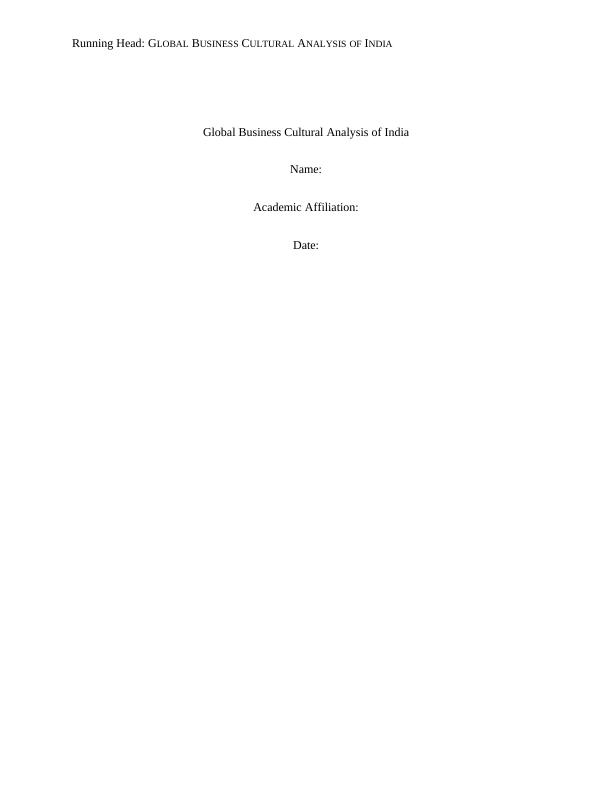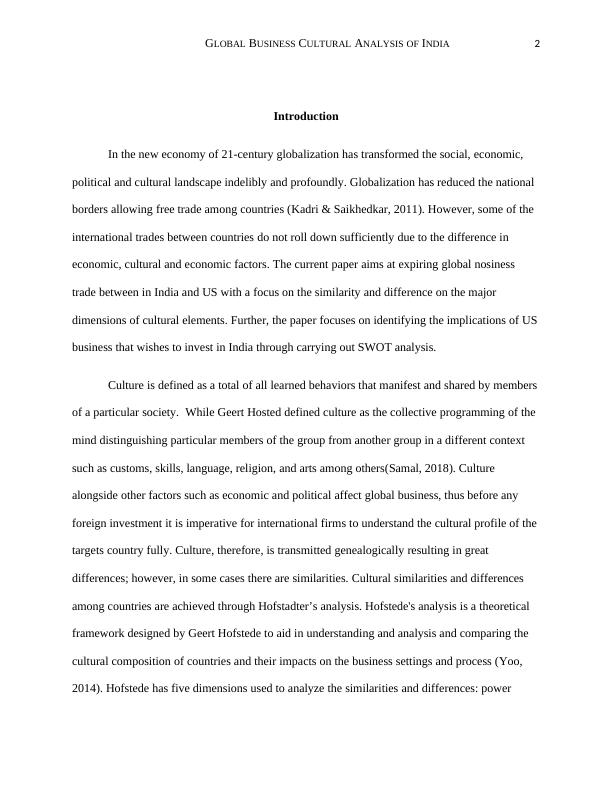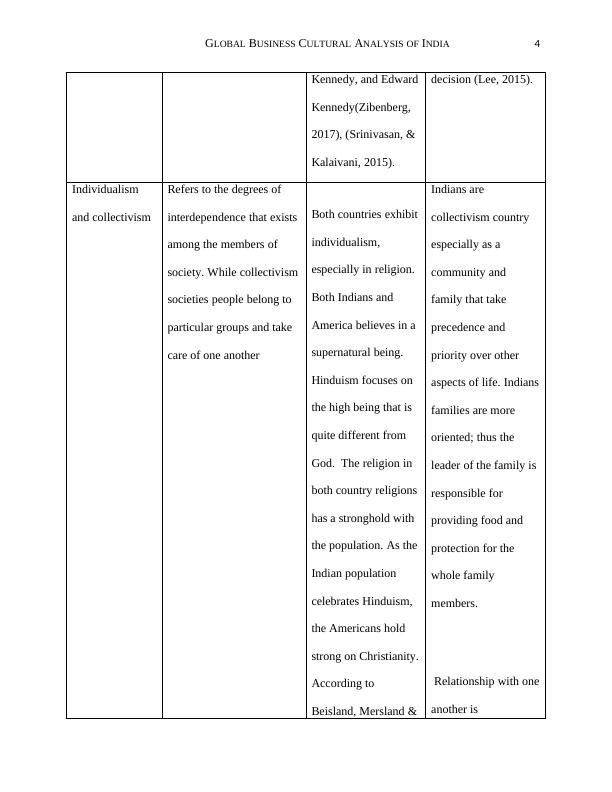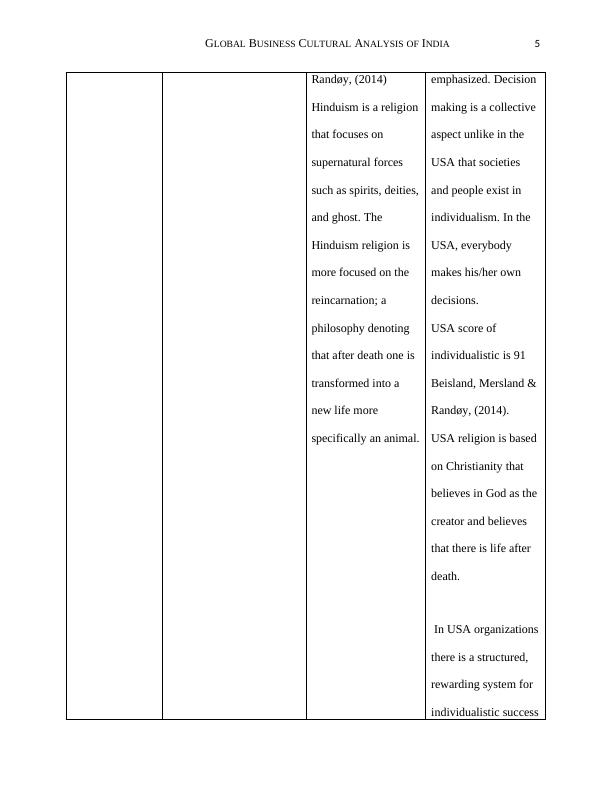Global Business Cultural Analysis of India
23 Pages4635 Words94 Views
Added on 2023-01-24
About This Document
This paper explores the cultural dimensions, similarities, and differences between India and the USA in the context of global business. It focuses on the implications for US businesses looking to invest in India and includes a SWOT analysis. Find study material and solved assignments on Desklib.
Global Business Cultural Analysis of India
Added on 2023-01-24
ShareRelated Documents
Running Head: GLOBAL BUSINESS CULTURAL ANALYSIS OF INDIA
Global Business Cultural Analysis of India
Name:
Academic Affiliation:
Date:
Global Business Cultural Analysis of India
Name:
Academic Affiliation:
Date:

GLOBAL BUSINESS CULTURAL ANALYSIS OF INDIA 2
Introduction
In the new economy of 21-century globalization has transformed the social, economic,
political and cultural landscape indelibly and profoundly. Globalization has reduced the national
borders allowing free trade among countries (Kadri & Saikhedkar, 2011). However, some of the
international trades between countries do not roll down sufficiently due to the difference in
economic, cultural and economic factors. The current paper aims at expiring global nosiness
trade between in India and US with a focus on the similarity and difference on the major
dimensions of cultural elements. Further, the paper focuses on identifying the implications of US
business that wishes to invest in India through carrying out SWOT analysis.
Culture is defined as a total of all learned behaviors that manifest and shared by members
of a particular society. While Geert Hosted defined culture as the collective programming of the
mind distinguishing particular members of the group from another group in a different context
such as customs, skills, language, religion, and arts among others(Samal, 2018). Culture
alongside other factors such as economic and political affect global business, thus before any
foreign investment it is imperative for international firms to understand the cultural profile of the
targets country fully. Culture, therefore, is transmitted genealogically resulting in great
differences; however, in some cases there are similarities. Cultural similarities and differences
among countries are achieved through Hofstadter’s analysis. Hofstede's analysis is a theoretical
framework designed by Geert Hofstede to aid in understanding and analysis and comparing the
cultural composition of countries and their impacts on the business settings and process (Yoo,
2014). Hofstede has five dimensions used to analyze the similarities and differences: power
Introduction
In the new economy of 21-century globalization has transformed the social, economic,
political and cultural landscape indelibly and profoundly. Globalization has reduced the national
borders allowing free trade among countries (Kadri & Saikhedkar, 2011). However, some of the
international trades between countries do not roll down sufficiently due to the difference in
economic, cultural and economic factors. The current paper aims at expiring global nosiness
trade between in India and US with a focus on the similarity and difference on the major
dimensions of cultural elements. Further, the paper focuses on identifying the implications of US
business that wishes to invest in India through carrying out SWOT analysis.
Culture is defined as a total of all learned behaviors that manifest and shared by members
of a particular society. While Geert Hosted defined culture as the collective programming of the
mind distinguishing particular members of the group from another group in a different context
such as customs, skills, language, religion, and arts among others(Samal, 2018). Culture
alongside other factors such as economic and political affect global business, thus before any
foreign investment it is imperative for international firms to understand the cultural profile of the
targets country fully. Culture, therefore, is transmitted genealogically resulting in great
differences; however, in some cases there are similarities. Cultural similarities and differences
among countries are achieved through Hofstadter’s analysis. Hofstede's analysis is a theoretical
framework designed by Geert Hofstede to aid in understanding and analysis and comparing the
cultural composition of countries and their impacts on the business settings and process (Yoo,
2014). Hofstede has five dimensions used to analyze the similarities and differences: power

GLOBAL BUSINESS CULTURAL ANALYSIS OF INDIA 3
distance, collectivism vs. individualism, avoidable uncertainty index, feminist vs. masculinity,
short term vs. long term orientation, and restraint vs. indulgence. Both India and USA have
different cultures and these cultures affect the business, thus before any USA investor goes into
the Indian market, should have extensive knowledge of the culture composition.
Cultural dimensions Similarities and differences between Indian and USA
Hofstede's
Factors
Definitions Similarities in India
and USA
Differences in India
and USA
Power Distance
Index
Refers to the extent to
which the less powerful
members of a society
expect and accept power
distribution unequally.
In both countries,
there are traces of
political dynasties that
resulted in numerous
tragedies. In India, the
political dynasty
begun with Motilal
Nehru to Nehru-
Gandhi, to Vijaylaxmi
Pandit to Indira
Gandhi and Rajiv
Gandhi while in the
USA it began with
Patrick Kennedy to
Joseph Kennedy, John
Kennedy, Robert
India and USA have
different power
distance index, with
India having a high
power distance index
of 77 while the USA
is having a low score
of 40 Chanida, 2015
). This means that
Indians appreciate
hierarchy from top to
down in society; thus
the subordinates
majorly depend on the
boss for every
distance, collectivism vs. individualism, avoidable uncertainty index, feminist vs. masculinity,
short term vs. long term orientation, and restraint vs. indulgence. Both India and USA have
different cultures and these cultures affect the business, thus before any USA investor goes into
the Indian market, should have extensive knowledge of the culture composition.
Cultural dimensions Similarities and differences between Indian and USA
Hofstede's
Factors
Definitions Similarities in India
and USA
Differences in India
and USA
Power Distance
Index
Refers to the extent to
which the less powerful
members of a society
expect and accept power
distribution unequally.
In both countries,
there are traces of
political dynasties that
resulted in numerous
tragedies. In India, the
political dynasty
begun with Motilal
Nehru to Nehru-
Gandhi, to Vijaylaxmi
Pandit to Indira
Gandhi and Rajiv
Gandhi while in the
USA it began with
Patrick Kennedy to
Joseph Kennedy, John
Kennedy, Robert
India and USA have
different power
distance index, with
India having a high
power distance index
of 77 while the USA
is having a low score
of 40 Chanida, 2015
). This means that
Indians appreciate
hierarchy from top to
down in society; thus
the subordinates
majorly depend on the
boss for every

GLOBAL BUSINESS CULTURAL ANALYSIS OF INDIA 4
Kennedy, and Edward
Kennedy(Zibenberg,
2017), (Srinivasan, &
Kalaivani, 2015).
decision (Lee, 2015).
Individualism
and collectivism
Refers to the degrees of
interdependence that exists
among the members of
society. While collectivism
societies people belong to
particular groups and take
care of one another
Both countries exhibit
individualism,
especially in religion.
Both Indians and
America believes in a
supernatural being.
Hinduism focuses on
the high being that is
quite different from
God. The religion in
both country religions
has a stronghold with
the population. As the
Indian population
celebrates Hinduism,
the Americans hold
strong on Christianity.
According to
Beisland, Mersland &
Indians are
collectivism country
especially as a
community and
family that take
precedence and
priority over other
aspects of life. Indians
families are more
oriented; thus the
leader of the family is
responsible for
providing food and
protection for the
whole family
members.
Relationship with one
another is
Kennedy, and Edward
Kennedy(Zibenberg,
2017), (Srinivasan, &
Kalaivani, 2015).
decision (Lee, 2015).
Individualism
and collectivism
Refers to the degrees of
interdependence that exists
among the members of
society. While collectivism
societies people belong to
particular groups and take
care of one another
Both countries exhibit
individualism,
especially in religion.
Both Indians and
America believes in a
supernatural being.
Hinduism focuses on
the high being that is
quite different from
God. The religion in
both country religions
has a stronghold with
the population. As the
Indian population
celebrates Hinduism,
the Americans hold
strong on Christianity.
According to
Beisland, Mersland &
Indians are
collectivism country
especially as a
community and
family that take
precedence and
priority over other
aspects of life. Indians
families are more
oriented; thus the
leader of the family is
responsible for
providing food and
protection for the
whole family
members.
Relationship with one
another is

GLOBAL BUSINESS CULTURAL ANALYSIS OF INDIA 5
Randøy, (2014)
Hinduism is a religion
that focuses on
supernatural forces
such as spirits, deities,
and ghost. The
Hinduism religion is
more focused on the
reincarnation; a
philosophy denoting
that after death one is
transformed into a
new life more
specifically an animal.
emphasized. Decision
making is a collective
aspect unlike in the
USA that societies
and people exist in
individualism. In the
USA, everybody
makes his/her own
decisions.
USA score of
individualistic is 91
Beisland, Mersland &
Randøy, (2014).
USA religion is based
on Christianity that
believes in God as the
creator and believes
that there is life after
death.
In USA organizations
there is a structured,
rewarding system for
individualistic success
Randøy, (2014)
Hinduism is a religion
that focuses on
supernatural forces
such as spirits, deities,
and ghost. The
Hinduism religion is
more focused on the
reincarnation; a
philosophy denoting
that after death one is
transformed into a
new life more
specifically an animal.
emphasized. Decision
making is a collective
aspect unlike in the
USA that societies
and people exist in
individualism. In the
USA, everybody
makes his/her own
decisions.
USA score of
individualistic is 91
Beisland, Mersland &
Randøy, (2014).
USA religion is based
on Christianity that
believes in God as the
creator and believes
that there is life after
death.
In USA organizations
there is a structured,
rewarding system for
individualistic success

GLOBAL BUSINESS CULTURAL ANALYSIS OF INDIA 6
such as solving a
particular problem,
unlike in India that the
whole group is
rewarded for the
success.
Doing business in
India is much based
on the relationship
that focuses on trust,
unlike in the USA that
business is based on
how best you can
outdo your competitor
and attract a customer.
Masculinity vs.
Feminist
Masculinity /feminism
refer to the values that are
exhibited in society
regarding male or female.
The masculine refers to the
preference in security for
achievement, assertiveness
and marital reward for
Both countries have
scored just above 50%
and are close. Indian
and the USA have as
the core of 56 and 62
5 respectively, an
indication that both
counties to be
The high score of the
masculine in the USA
of 62 indicates that
society is driven by
competition, success,
and achievements that
start from childhood
towards adulthood.
such as solving a
particular problem,
unlike in India that the
whole group is
rewarded for the
success.
Doing business in
India is much based
on the relationship
that focuses on trust,
unlike in the USA that
business is based on
how best you can
outdo your competitor
and attract a customer.
Masculinity vs.
Feminist
Masculinity /feminism
refer to the values that are
exhibited in society
regarding male or female.
The masculine refers to the
preference in security for
achievement, assertiveness
and marital reward for
Both countries have
scored just above 50%
and are close. Indian
and the USA have as
the core of 56 and 62
5 respectively, an
indication that both
counties to be
The high score of the
masculine in the USA
of 62 indicates that
society is driven by
competition, success,
and achievements that
start from childhood
towards adulthood.

End of preview
Want to access all the pages? Upload your documents or become a member.
Related Documents
Cultural Analysis for IKEA's Expansion in Indialg...
|12
|1228
|222
Intercultural Relations: A Comparison of French and Indian Cultureslg...
|8
|1474
|399
Hofstede Cultural Dimension Model and its Application in HSBC Operations in Indialg...
|10
|875
|82
Modernization and Globalization PDFlg...
|7
|1531
|18
Business Communication: Hofstede Model for Intercultural Analysislg...
|4
|698
|326
Cultural Dimension Analysis of Canada and Indialg...
|10
|1797
|469
